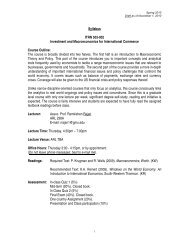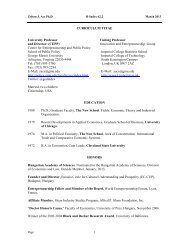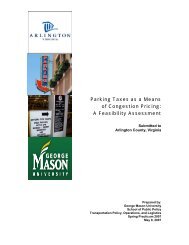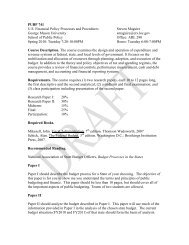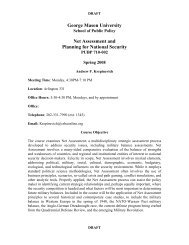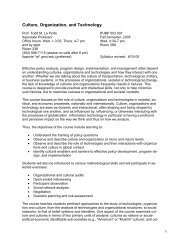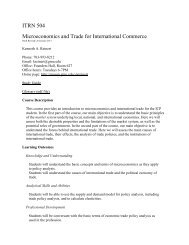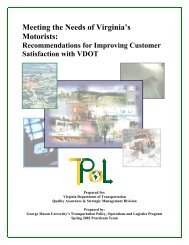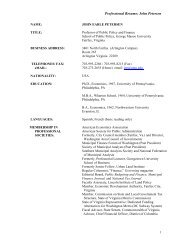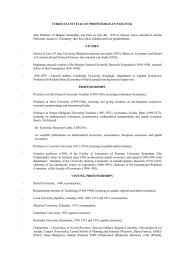Cost Benefit Analysis of Washington-Richmond High-Speed Rail
Cost Benefit Analysis of Washington-Richmond High-Speed Rail
Cost Benefit Analysis of Washington-Richmond High-Speed Rail
Create successful ePaper yourself
Turn your PDF publications into a flip-book with our unique Google optimized e-Paper software.
<strong>Cost</strong> <strong>Benefit</strong> <strong>Analysis</strong> <strong>of</strong> <strong>Washington</strong>-<strong>Richmond</strong> <strong>High</strong>-<strong>Speed</strong> <strong>Rail</strong> Spring 2010<br />
The research findings show that reducing congestion through better managed freeways has numerous<br />
documented benefits, including “reducing travel times, smoothing the travel flow, increasing average<br />
fuel economy and reducing vehicle queuing.” However, our study on HSR from <strong>Washington</strong> to <strong>Richmond</strong><br />
will show that all the mentioned benefits will be realized with the implementation <strong>of</strong> HSR, as a potential<br />
countermeasure to congestion on the <strong>Washington</strong>-<strong>Richmond</strong> corridor.<br />
Traffic congestion is a widely recognized transportation cost. Several methods can be used to quantify<br />
and monetize this cost, which can provide different results, as shown in Table 7-2. 61 The most<br />
appropriate approach for many applications, although difficult to perform, is to calculate the marginal<br />
delay caused by an additional vehicle entering the traffic stream, taking into account the speed-flow<br />
relationship <strong>of</strong> each road segment. 62 Another approach is to determine the user fee needed to reduce<br />
demand to design capacity, based on travelers’ willingness-to-pay for road use. A third approach is to<br />
calculate unit costs <strong>of</strong> current expenditures on congestion reduction projects. In theory these three<br />
methods should produce similar values, assuming that roadway capacity is expanded based on vehicle<br />
delay costs as reflected in vehicle users’ willingness to pay, but in practice they <strong>of</strong>ten provide different<br />
results. 63<br />
48<br />
Table 7-2: Previous Congestion <strong>Cost</strong> Studies<br />
This table summarizes key congestion cost studies. These estimates range widely since they have been<br />
produced using different methods for different purposes. More detailed descriptions <strong>of</strong> these studies<br />
61 Miller and Li, “Investigation <strong>of</strong> the <strong>Cost</strong>s <strong>of</strong> Roadway Traffic Congestion” (California PATH, 1994)<br />
62 Anthony Downs , “Stuck in Traffic” (The Brookings Institute), www.brookings.edu<br />
63 Terry Moore and Paul Thorsnes , “The Transportation/Land Use Connection, Report ” (American Planning<br />
Association, 1993), www.planning.org



